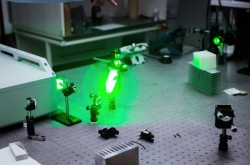Gamma radiation visualization system for radioactive contamination monitoring
Anna Vasilyeva, a Ph.D. student at the Department of Optical-Electronic Devices and Systems, began her work on the project while preparing her Ph.D. thesis. Initially, the project entailed the creation of a gamma radiation spectrometer, but in the course of analyzing relevant research, she discovered that a visualization system would be a more effective solution and, besides, there are few such projects in existence right now.
“What makes this project unique is that the gamma channel is based on a solid-state silicon photomultiplier (SiPM) – an advanced particle detector which is very rarely used in gamma radiation visualization. These days, CCD or CMOS detectors are usually used for this purpose. We believe that using a SiPM will help improve the properties of gamma radiation visualization systems,” – explains project lead Anna Vasilyeva.
The device is intended to solve the issue of detecting and visualizing sources of gamma radiation. It may be used in safety systems for prevention of radiation-related emergencies, as well as in industrial conditions and in environmental monitoring when conducting radiation mapping.

At the project’s current stage, an analysis of the current research has been carried out and an outline for the system’s structure has been developed. The core work on the project is expected to last two years; the financing for the project implementation time amounts to 3.5 million rubles. A prototype model will be constructed and tests are to be conducted – including ones involving radiation sources. The main consumers of the system will likely be nuclear energy plants, where the devices can be used for monitoring, diagnostics and prevention and response to emergencies, as well as security services (the system can be used to prevent radiation terrorism in places of mass gathering and for border and customs control) and environment monitoring services.
Development of a laser diode module with a fiber output for additive technologies.
The project concerns the development of a high-efficiency laser diode module capable of continuous operation – explains Ekaterina Kotova, project head and assistant at Department of Light Technologies and Optoelectronics. Such models have a wide range of application: dark lights for video surveillance, pumping solid-state lasers, medicine and additive technologies.
The main advantages of laser diode modules are their high efficiency, low cost and small size. Thanks to these properties, they stand out among the fiber and CO2 lasers that are widely used in industrial 3D printers. However, the laser diodes and devices based on them which are produced in Russia are only capable of quasi-continuous operation.
“Creating continuous-operation modules is a difficult task; a wide range of issues have to be solved. This includes, for instance, having to create an effective heatsink: if a sufficient amount of heat is not redirected, the diodes overheat and degrade. This makes their output parameters drop and may even lead to complete breakdown of a device. We also need to create a high-efficiency optical system inside the module in order to collect optical power from several sources and contain it in one small strand of optical fiber to transfer it to the point of use. Finally, we need to learn how to assemble and tune the system’s elements so as not to lose the intended technical potential and ensure high specs in the end product,” – comments Ms. Kotova – “You could say that we’re assembling the system whole from separate parts, and each of the parts must be perfectly tuned and result in maximum efficiency”

Therefore it is necessary that the radiation source (the laser module) consume little electrical power, be as space-efficient as possible while putting out as much optical energy as possible, and operate steadily and for long periods of time. A radiation source with these properties would increase the accessibility of additive technologies and improve the technical parameters of devices that require compact, effective radiation sources. One such device is a 3D printer: an emitter module is one of the key elements of printer heads in 3D printers, and, as of now, it often makes up something like 60% of a device’s cost.
The developers note that, in the future, the project will make it possible not only to produce high-efficiency laser modules while increasing the qualifications and experience of its development team, but to also find out how it can be applied and integrated into various devices. The project is expected to last two years and the financing comes up to a total of 5 million rubles including the funds allocated from the resources of the Department of Light Technologies and Optoelectronics.
As of now, the project is transitioning from the research stage to the development stage; the developers have conducted a review of the current knowledge in the relevant field, compiled the requirements for the basic elements of the module, determined the required components and fleshed out the design and structure of it. Soon, a project team will be assembled to begin working on the project according to the outline up to its hardware implementation.
Development of a transmitter-receiver system based on Light ID technology
This project by Arina Kremleva, assistant at the Department of Light Technologies and Optoelectronics, aims to create a system based on Light ID technology, at the core of which is the unification of widely used LED lighting with the ability to transfer data.
As the project lead notes, data transfer using a Light ID module provides numerous opportunities and has a number of advantages over its other counterparts.
First of all, it can be integrated into any objects that employ artificial lighting without affecting their visual characteristics (which is especially relevant for culturally significant objects). The technology can also let users receive information about an object. Notably, no Internet connection is required.

In addition, the device is implemented in such a way that it can dynamically change the data transferred to users without affecting the lighting or the module. One other advantage is that the receiving part is software-based and can be downloaded onto a smartphone. Finally, the implementation of an intelligent lighting system is possible in place with existing lighting systems without the need to replace the lighting fixtures themselves. These factors make the technology easily accessible to end users, who are not required to possess any special skills to use it.
“The main issue this project may solve is the need to create new information environments in cities for both locals and tourists. By installing an app on your phone in advance, you get the information about the sights, museum pieces, streets, houses and other objects highlighted with LEDs. Our module will tell you all about these things in real-time without the need to connect to the internet and waste data traffic. You can simply point your smartphone at an object and there it is,” – explains Ms. Kremleva.
The project is expected to last two years and has been financed for 3.5 million rubles. The project is currently in early stages of development: a prototype exists which is able to transfer data from one unit to another; the project team plans to soon conduct a series of experimental tests and to develop a mobile application. One of the project’s key prospects, Arina Kremleva noted, is its use in the implementation of the St. Petersburg Development Program (a project designed and carried out by ITMO University’s Higher School of Lighting Design and state unitary enterprise Lensvet).





